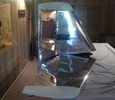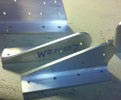


random user submitted photo
Nav/Strobe Lights
32 posts
• Page 4 of 4 • 1, 2, 3, 4
Re: Nav/Strobe Lights
Fastcapy wrote:How would one go about documenting the lights meet requirements?
Usually, if the lights meet the requirements you can get documentation from the manufacturer stating so. If you can't, then you might want to look at a different product.
Fastcapy wrote:I don't really see the FAA looking into it unless they are investigating an accident or some other violation like busting a TFR at night, but what would someone show the FAA if they were questioned on it.
This is exactly correct. This is not something the FAA would routinely look for. It's only after they're already looking at someone for some violation that they made decide to use the proverbial "fine tooth comb" to see what else they can pile on. The only other possible scenario would be to fly an aircraft with obviously sub-standard lights into a controlled field at night and get reported by the controllers. That's not likely to happen with the ultra-bright LED lights we're talking about here.
But if the FAA would ever ask, the aforementioned paperwork from the light manufacturer would the the answer.
Fastcapy wrote:Also, not to get off track but could the same not be done with transponders then? I mean if I call ATC for a readout on their end and it is the same as I show in the cockpit could one not document that as self certifying the correct operation of it?
Nope, a transponder is a different animal. Compliance with transponder testing is called out in 91.413, which includes specific language on who must do the testing and to what standard.
Fastcapy wrote:Also, I noticed looking at the AC documents Joe provided that the most recent one was from 1981...
Maybe the FAA needs to look at updating these to keep in tune with the new LED lighting and the huge amount of these lights going on Experimental aircraft.
Actually, there hasn't been a change in what's required as far as intensity, color, or visibility, regardless of whether it's LED or incandescent or whatever, so there's really no reason to update the documents. The new LED lights should more than meet the requirements. In the context of this discussion, it's all about documentation. The bottom line is, if you can't get documentation from the manufacturer stating that the lights meet the FAA requirements, you may want to look at different lights. (Or just fly the plane in day-VFR conditions, and it won't matter.)
Joe Norris
Sonex N208GD (S/N 450)
Sonerai II N13NN (S/N 1206)
Fortes Fortuna Adiuvat
Sonex N208GD (S/N 450)
Sonerai II N13NN (S/N 1206)
Fortes Fortuna Adiuvat
-

Sonerai13 - Posts: 415
- Joined: Tue Nov 05, 2013 5:36 pm
- Location: Oshkosh, WI
Re: Nav/Strobe Lights
-Removed-
Mike Beck
Oshkosh, WI (KOSH)
Sonex #1145 N920MB
Std Gear, Modified Aerovee, Rotec TBI, Dual Stick, Acro Ailerons
MGL Panel
Airworthiness: 10/24/13, First Flight: 05/18/14
Oshkosh, WI (KOSH)
Sonex #1145 N920MB
Std Gear, Modified Aerovee, Rotec TBI, Dual Stick, Acro Ailerons
MGL Panel
Airworthiness: 10/24/13, First Flight: 05/18/14
- Fastcapy
- Posts: 335
- Joined: Sun Jan 12, 2014 11:45 am
- Location: KOSH
32 posts
• Page 4 of 4 • 1, 2, 3, 4
Who is online
Users browsing this forum: No registered users and 19 guests







